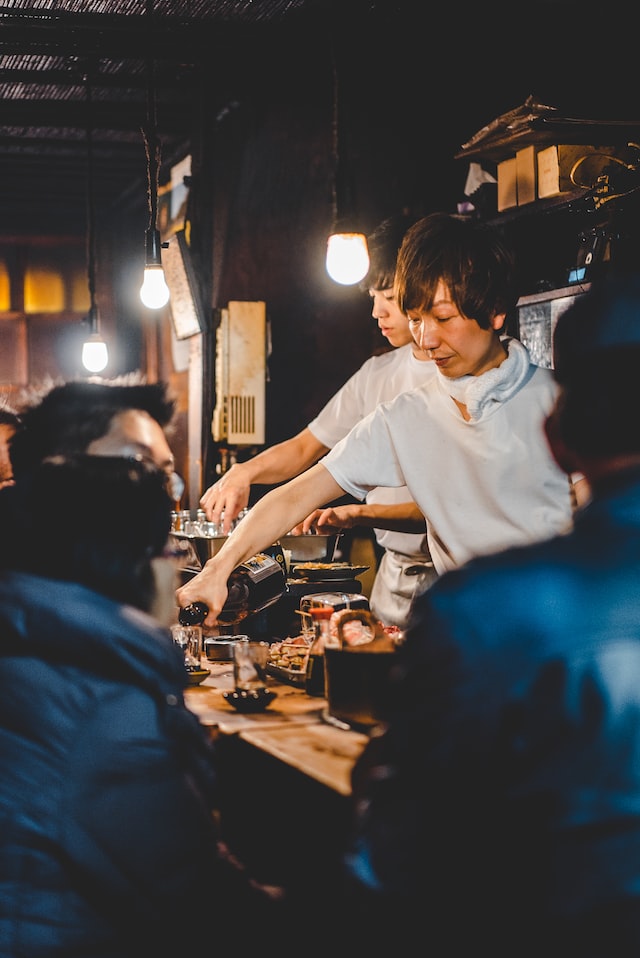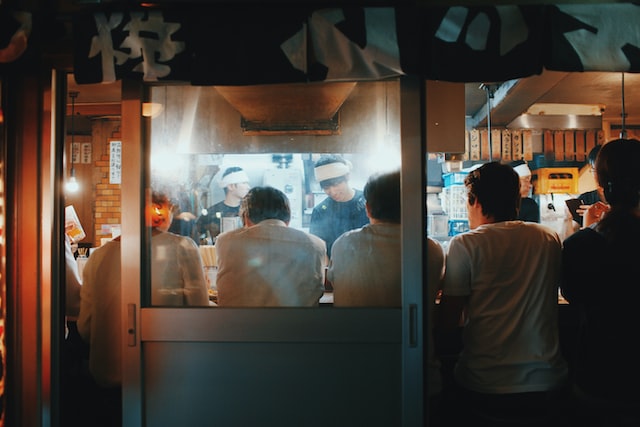As the sun began to set, the streets of Tokyo came alive with the sounds of laughter, chatter, and clinking glasses. Japanese businessmen and women congregated in izakayas, small bars that occupy every nook and cranny of the city. These unassuming establishments offer a place to unwind after a long day of work, indulge in sake and beer, and savor delectable bites of Japanese cuisine.
The air inside the izakaya was thick with the fragrance of grilled meats, soy sauce, and sesame oil. The lighting was dim and cozy, with lanterns casting a warm glow on the faces of the patrons. At the bar, a group of friends were embroiled in a heated debate over who had the best tonkatsu in the city. At a table nearby, a couple shared an intimate moment, clinking their glasses and murmuring sweet nothings between bites of sushi.

The izakaya was a social hub, a place to gather with friends, colleagues, and loved ones — where Japan’s drinking culture mainly revolves. The atmosphere was welcoming, with a sense of conviviality that made even strangers feel like old friends. As the night went on, the energy in the room heightened, fueled by the lively conversation, alcohol, and boisterous exclamations of “kanpai!” – the Japanese equivalent of “cheers!”
In this unpretentious environment, the food was the star of the show. From crispy tempura to savory yakitori, each dish was crafted with care and skill. The flavors were both familiar and exotic, drawing on traditional Japanese ingredients like miso, nori, and wasabi. And yet, there was a modern twist to the fare, with chefs experimenting with fusion flavors and new techniques, pushing the boundaries of what was once considered “authentic” Japanese cuisine.

The izakaya was a microcosm of Tokyo itself – vibrant, diverse, and endlessly fascinating. It was a place where people could come together to eat, drink, and be merry, whether they were celebrating a milestone, having a casual night out, or simply enjoying the moment. In this city that never sleeps, the izakaya was a sanctuary, a haven of warmth and comfort amidst the hustle and bustle of daily life.
Japanese Drinking Norms
Here are the norms of drinking in Japan:
When entering an izakaya, it is customary to say, “Irasshaimase,” which means “welcome” in Japanese. Once seated, guests are handed a menu, which is typically written in Japanese, but may have a picture of the dish so the diners can point to what they want. It is common to share dishes family-style, so everyone tries a bit of everything.
The drinks menu is just as important as the food in an izakaya. Traditional Japanese beverages like sake and shochu are popular choices, as well as beer and whisky. It is customary to pour drinks for others at the table and not pour your own. When someone pours for you, it is polite to hold your cup with both hands and thank the pourer with a nod of your head.
Izakaya culture has evolved over time, catering to different preferences and lifestyles. For example, there are now non-alcoholic izakayas, where customers can enjoy the food and atmosphere without the presence of alcohol. Some izakayas also offer karaoke, board games, or even allow smoking.
Despite these changes, however, one thing has remained constant – the izakaya’s role as a place for socializing and enjoying good food and drinks with loved ones. Perhaps even more so in today’s increasingly digital world, the izakaya serves as a reminder of the importance of face-to-face interactions and the joy of sharing a meal with others.

